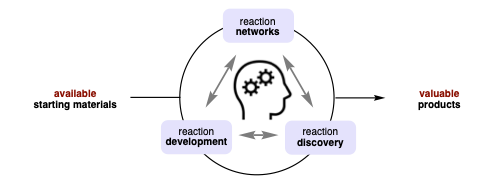
University Assistant Professor
PhD Opportunities
We welcome motivated and creative candidates interested in joining the Dydio Lab to pursue a PhD starting in October 2026. For further information about available projects and application procedures, please contact pd552@cam.ac.uk.
Research
The Dydio group is researching new ways to improve the efficiency and capacity of organic synthesis.

Areas of interest include:
- Complex Networks of Reactions
- Mechanism-based design of new transformations
- Advancing key industrial processes driven by elucidating their mechanistic features
Watch Dr Dydio discuss his research
Publications
Supramolecular Control of Selectivity in Hydroformylation of Vinyl Arenes: Easy Access to Valuable β‐Aldehyde Intermediates
Angewandte Chemie International Edition
(2013)
52
3878
(doi: 10.1002/anie.201209582)
Dynamic Combinatorial Chemistry in Chemical Catalysis
Israel Journal of Chemistry
(2013)
53
61
(doi: 10.1002/ijch.201200083)
7,7′-Diamino-2,2′-diindolylmethane: A Building Block for Highly Efficient and Selective Anion ReceptorsuStudies in Solution and in the Solid State
Chemistry
(2012)
18
13686
(doi: 10.1002/chem.201201909)
"Cofactor"-Controlled Enantioselective Catalysis
J Am Chem Soc
(2011)
133
17176
(doi: 10.1021/ja208589c)
Benzopyrrole derivatives as effective anion receptors in highly competitive solvents
Pure and Applied Chemistry
(2011)
83
1543
(doi: 10.1351/pac-con-10-11-11)
Amide - and urea-functionalized pyrroles and benzopyrroles as synthetic, neutral anion receptors
Chem Soc Rev
(2011)
40
2971
(doi: 10.1039/c1cs15006e)
Remote Supramolecular Control of Catalyst Selectivity in the Hydroformylation of Alkenes
Angewandte Chemie
(2011)
123
416
(doi: 10.1002/ange.201005173)
Remote supramolecular control of catalyst selectivity in the hydroformylation of alkenes.
Angew Chem Int Ed Engl
(2011)
50
396
(doi: 10.1002/anie.201005173)
7,7′-Diureido-2,2′-diindolylmethanes: Anion Receptors Effective in a Highly Competitive Solvent, Methanol
Organic letters
(2010)
12
1076
(doi: 10.1021/ol1000395)
Anion receptors based on 7,7′-diamido-2,2′-diindolylmethane
Chemical communications (Cambridge, England)
(2009)
4560
(doi: 10.1039/b907164d)
- ‹ previous
- Page 4

